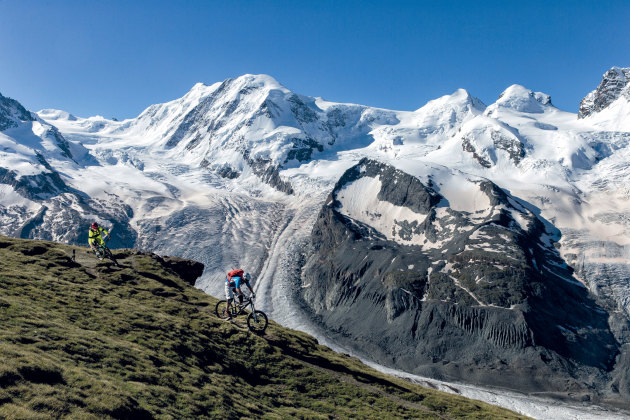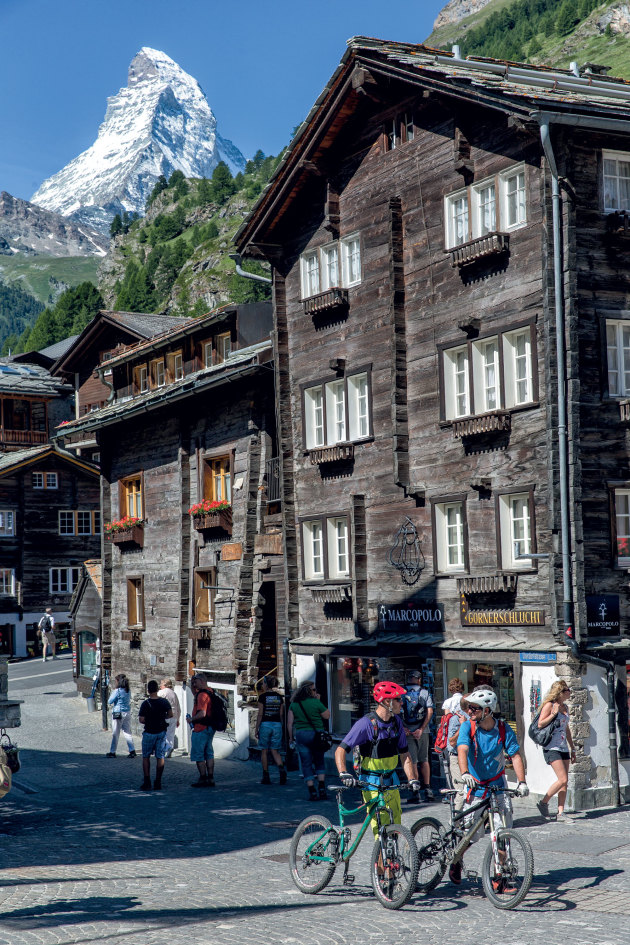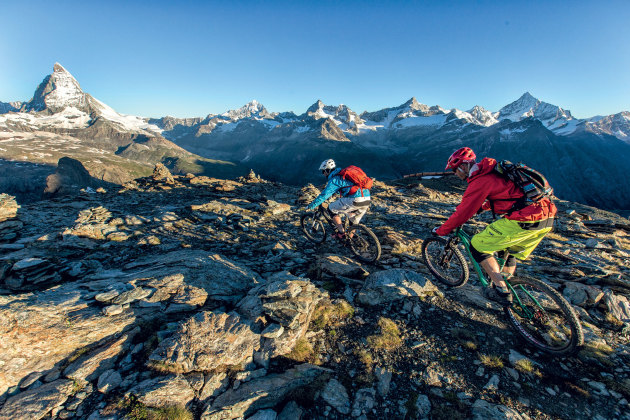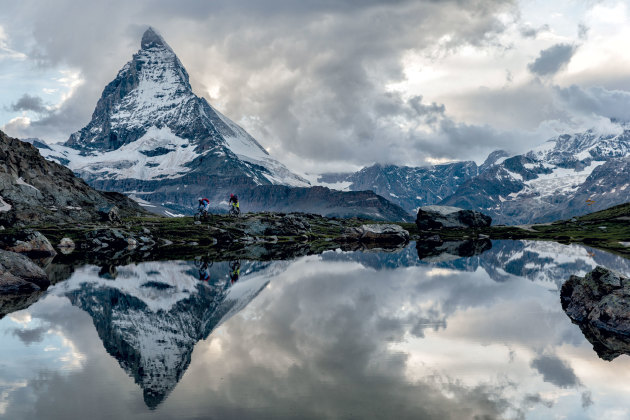Mountain Biking in the Swiss Alps
Think of Swiss chocolate and there’s a good chance that you’ll picture a block of Toblerone, and on the packaging you’ll find a depiction of the Matterhorn—there’s something inherently mystical and entrancing about it.
Switzerland has no shortage of 4,000 metre high Alpine peaks but the Matterhorn is by far and away the most famous. So if you’re planning a Swiss getaway, there’s a good chance that viewing this prominent pyramid will be on your hit list.
The tourist town of Zermatt sits right next to the Matterhorn, tucked into the upper end of the Matter Valley in the canton of Valais, southern Switzerland (the country is divided into 26 ‘cantons’ or states). While it is in a valley, the village already stands 1,640 metres above sea level—about the same elevation as the Falls Creek ski resort back home. From here the 4,478m high Matterhorn looms, towering above the town centre.
It mightn’t be the tallest Swiss peak (that’s the 4,634m Monte Rosa, right on the Swiss-Italian boarder) but it has a formidable reputation. The Matterhorn remained unclimbed after most Alpine peaks had been conquered and it became the subject of an international competition for the summit. The first ascent of the Matterhorn was finally made in 1865 but only three of the seven climbers survived the descent. The western face of this peak wasn’t climbed until 1962 and over 500 climbers have lost their lives on the Matterhorn. Looking upwards at the peak, it’s easy to see why; the walls are sheer, jagged and ice encrusted year round—it’s the quintessential Swiss icon.
MTB Shift
Conquering the Matterhorn mightn’t be on your agenda but there’s a host of other activities on offer. Obviously skiing is the focus during for winter but like many alpine villages globally, mountain biking is becoming a key activity for the warmer months. With Zermatt being a longstanding adventure tourism and outdoors hotspot, there’s a massive amount of infrastructure in place to move people around and get you up the mountains; both gondolas and cog railways. Purchasing a bike ticket allows you to take advantage of this system and lets you make the most out of the riding. Don’t think of it as a soft option either; the hills here are big, real big!
With the surrounding alpine areas hovering around 3,000m above sea level, many of the best trails start well over 1,000 metres vertical metres above Zermatt. That’s a huge hike and will absorb a large chunk of your ride time and energy before the fun starts, and the altitude only serves to exacerbate matters. Unless you live at Guyra or Cabramurra, the effects of altitude really start to kick in once you’re above 2,000m, so you expect to suffer with shortness of breath and elevated breathing rates—not what you want when faced with a 1,500 metre climb!
Faced with limited time, we employed the services of a local guide. Adrian Greiner – a member of Bikeschool Zermatt – ensured that we got in the best bits of trail with the best scenery and attractions. Of course you can always get your own maps and go it alone, but it’s best to plan a longer stay if you want to do your own exploration.
We arrived a day prior to hitting the trails, giving us time to look around Zermatt. While it’s a bustling town, packed with tourists from across the globe, it’s also completely free from combustion engine vehicles—that’s right, no cars in Zermatt! You’ll encounter electric buses that provide a shuttle service around town as well as some electric vehicles used to transport goods but on the whole Zermatt is surprisingly quiet due to the complete lack of traditional cars. Interestingly, this policy was originally implemented to reduce air pollution with the aim of maintaining a crisp, clear view of the mighty Matterhorn.
To get to Zermatt you need to leave your vehicle at Tasch, around 6km back down the valley and catch the cog railway from there. There’s tons of parking at Tasch and the trains leave at regular 20-minute intervals. You can also utilise the Swiss rail network and travel to Tasch via Bern and Visp, a three and a half hour journey.
There’s an eclectic mix of old and new in town, with historic exposed beam wooden chalets housing everything from designer boutiques to a McDonalds—it’s certainly a curious place! Of course we were keen to explore beyond the retail centre and hit the trails. Our time would come and we were pumped!

Climb Easy
The following morning we boarded the Gornergrat cog railway, which climbs 1,500 metres through Riffelalp and Riffelberg before topping out at 3,135m—it’s the highest open-air railway in Europe. The half-hour trip delivered us to a surreal moonscape; it’s surrounded by several glaciers and 29 peaks that rise above 4,000 metres. There’s also an astronomical observatory, a three star hotel, two restaurants, a small shopping mall and a swarm of other tourists—not exactly what you’d expect to find on a mountain at over 3,000 metres above sea level! To top it off you’ll find long-bearded men with alphorns and Bernese mountain dogs ready and waiting to pose for postcard pictures—for a fee of course.
By now we’d had enough and left the crowds and kitsch scene behind to discover our own less hectic slice of Switzerland. We were lucky as it was a clear and crisp alpine day and the Matterhorn stood before us against the steel blue sky. Although this wasn’t our first glimpse of the peak, it never fails to impress. Now heading downhill and back towards Zermatt, the trail is hard-packed with embedded rocks. While it’s not overly technical, it takes a conscious effort to tear our eyes from the scenery and focus on the trail, especially with the impressive Gorner Glacier to our left—the second largest glacial system in the Alps.

There are numerous variations on the route back to Zermatt but the signage is pretty comprehensive along the way, just ensure that you’ve got a decent walking or riding map on hand to make sense of it all. In our case we just had to follow Adrian for a stress-free guided tour, taking in postcard-worthy alpine tarns that are perfect for a refreshing summer dip.
Before long the trail became steeper and rockier, forcing us to pick our lines with care. Once below the treeline the terrain changed yet again, with the soil turning loamy and smooth with tree roots and numerous natural jumps.
Around 15km after leaving Gornergrat station and 1,500m lower in elevation, Adrian led us into a small town just above Zermatt. The classic wooden buildings make you feel like you’ve stepped back in time. One of these houses was a small restaurant, serving the local specialties; Käserösti (a cheese potato cake topped with Gruyère cheese) and homemade rhubarb tart refilled our tanks. While the cosy atmosphere encouraged us to linger, Adrian urged us on—there are too many trails to explore!

Funicular Fun
To save time and energy, we again utilise the train system to minimise the climbing. This time, an underground funicular took us from Zermatt up to Sunnega at 2,288m; the stepping off point for a number of gravity trails. From the station we took a short but steep climb to the top of the trail. This time Adrian had something more technically challenging; a steep and splinted path that serpentined down the mountain. It was quite exposed in places and not the sort of place where you’d want to take a tumble, but as with everywhere around Zermatt, the views were breath taking.
Further down the trail levels and rolls smoothly along the soft forest floor towards the valley. It is one of those trails where you neither have to brake, nor step on the pedals while still being able to carry the perfect speed—the essence of a flow trail.
All of a sudden we were back in Zermatt at the valley station, so without further ado we headed straight back up to Sunnega to do it all again!

A few hours later we were all sitting in Zermatt with a well-deserved beer. Swiss flags hung above us and we had a view of the Matterhorn, standing at the end of the valley glowing red in the setting sun. We’d taken on a huge variety of trails within such a relatively small area and the scenery will leave you gobsmacked; point your camera just about anywhere and you’ll get a veritable postcard. Of course we’d only just scratched the surface and there’s so much more to see and do—we’ll certainly be back for more.

General Information
Getting There
Zermatt is located in the Canton of Valais in southern Switzerland, near the Italian border. The car-free town is accessible by train, taxi or helicopter. Catching the train to Zermatt is quite an experience. Just park your car in Tasch and the trains leave every 20 minutes. The trip from Tasch to Zermatt takes 12 minutes.
The drive time to Tasch is around three hours from Zurich or 2:45 from Geneva.
If you’re flying into Zurich, you can travel to Zermatt via the Swiss rail network; it’s a 3.5 hour journey. Alternatives include flying in via Air Zermatt helicopters or catching the Glacier Express train, which departs from St Moritz.
- www.swissrailways.com
- www.glacierexpress.ch

When to Visit
From July to October is best, although it can snow at any time of year once you are at altitude. Make sure you pack for all conditions as the weather can change quickly in the mountains—always take a wind/waterproof jacket, just in case.
Bike Shops & Rental
Bayard Sport - www.bayardzermatt.ch
Slalom Sport - www.slalom-sport.ch
MTB Guides
Bikeschool Zermatt, Adrian Greiner - www.bikeschoolzermatt.ch

Maps & Trail Guides
Singletrail Map for Zermatt/Saas Fee - www.singletrailmap.ch
Super Trail Map for Zermatt/Saas Fee - www.supertrail-map.com
Where to Stay
Switzerland isn’t the cheapest place to stay and Zermatt itself can be pretty pricy. Small hotels cost from AU$150 per night and rise rapidly from there. Budget rates are often available through online sites such as www.agoda.com.
Mountain huts/refuges are a great option, especially if there are a few of you. They are like youth hostels and can be quite cheap; www.sac-cas.ch.
You’ll also find some great campsites in the area - www.myswitzerland.com
For general information and more accommodation go to - www.zermatt.ch

Food & Drink
You’ll find great restaurants and food all through the Valais, especially if you’re a cheese lover. Local cheeses are eaten with most things—forget chocolate, the real Swiss delight is cheese!
The most famous regional dish is fondue; a bowl of hot melted local cheese and white wine seasoned with herbs. Fondue is eaten with bread or with potatoes. If that’s not to your taste try ‘raclette’ which is the other regional speciality; its potato with melted cheese and cured hams and pickles.
If you’re not a cheese lover then try rosti; a huge hash brown-like mix of compounded fried potatoes. Of course, you will find plenty of everything else on offer too, especially Italian food and meat dishes.
As for drinks, the Valais region has some of the best white wines in Europe and the regional reds are good too, as is the beer.
Trail Etiquette
Depending on the area and season, you can encounter quite a few hikers on the trails. Always slow down, give the walkers right of way and be considerate (a bell is recommended). With the more popular walking routes, it’s best to ride during the off-peak hours.

Endless Options
With the help of our guide from Bikeschool Zermatt, we were able to sample some of the best trails close to town. However, if you’ve got more time to spare, a whole world of adventure awaits. Around the Valais, MTB access is relatively free and easy; you can ride any of the walking tracks unless they are specifically marked as being out of bounds.
While these tracks mightn’t be as groomed, flowy and jump filled as the MTB specific trails, the network of walking trails is huge and far-reaching, allowing for a real ‘choose your own adventure’ backcountry experience.
Switzerland is also gifted with a network of alpine huts that cater for walkers, bikers, skiers and other adventurers. While some can be a little rustic, they’re streets ahead of your average Aussie alpine hut. Many run year round providing food and accommodation at reasonable rates (by Swiss standards).
Utilising these huts can provide a high altitude base camp that allows you to explore further and access some real Swiss epics. Their remoteness also lets you get up close with the wildlife; you stand a better chance of sighting something like a alpine ibex once the crowds have retreated back to Zermatt.
If you’re really adventurous, you can tackle a multi-day ride utilising the alpine huts for accommodation. Why not follow the route of the Perskindol Swiss Epic; a 130km point to point race that takes you from the ski resort of Verbier to Zermatt with 3,234 metres of climbing along the way.














